Thermal Mitigation in Coastal Cities: Marine and Urban Morphology Effects on Land Surface Temperature in Xiamen
Abstract
1. Introduction
- Accurately retrieve LST across Xiamen using Landsat 8 data.
- Quantify relationship between UCE and LST and determine the ocean’s cooling range.
- Determine impact of three urban morphology factors (building density; green space ratio and water space ratio) on the urban thermal environment from a spatial perspective and propose corresponding optimization strategies.
2. Materials and Methods
2.1. Study Area
2.2. Materials
2.3. Grid Study Area
2.4. Atmospheric Correction Method
2.5. Bivariate Spatial Auto-Correlation Model
2.6. Carbon Emission Calculation
2.7. Spatial Interpolation Method
2.8. Multiscale Geographically Weighted Regression Model
3. Results
3.1. Spatial Distribution Characteristics of Carbon Emissions and Thermal Environment in Xiamen
3.2. Bivariate Spatial Multivariate Correlation Between Carbon Emissions and Surface Temperature
3.3. Spatial Variability in the Relationship Between Urban Form and Thermal Environment Correlations
3.3.1. Ocean-Influenced Areas: Urbanization Overrides Vegetation and Water Cooling
3.3.2. Areas Less Influenced by the Ocean: Stronger Building Cooling Effect
3.3.3. Areas Not Influenced by the Ocean: Vegetation Cooling Dominates
4. Discussion
4.1. Spatial Impact Range of Ocean on Thermal Environment
4.2. Spatial Differences in Urban Morphological Factors Under Ocean Influence
4.3. Urban Morphology Optimization Strategies for Thermal Mitigation Goals
4.3.1. Ocean-Influenced Areas: Establishing Green Corridors in Southern Coastal Regions
4.3.2. Areas Less Influenced by the Ocean: Enhancing Spatial Complexity in Tong’an District
4.3.3. Areas Not Influenced by the Ocean: Green Space Expansion and Impervious Surfaces Reduction in Outer Island Regions
5. Conclusions
- For coastal cities with complex topographies, future research should be dedicated to developing customized urban planning strategies that account for the intricate interactions between topography and the ocean in shaping the thermal environment. This may involve the use of numerical simulation models to predict the thermal environment under different topographic and urban design scenarios.
- In terms of data collection and analysis, future studies should strive to amass more comprehensive datasets, including high-resolution remote sensing data with multi-spectral and multi-temporal information, as well as detailed socio-economic data at the neighborhood level. Such comprehensive data will enable more accurate modeling and prediction of the urban thermal environment, thereby providing a robust scientific basis for evidence-based urban planning and management.
Author Contributions
Funding
Data Availability Statement
Conflicts of Interest
References
- Oke, T.R. The energetic basis of the urban heat island. Quart. J. R. Met. Soc. 1982, 108, 1–24. [Google Scholar] [CrossRef]
- Zhu, E.; Qi, Q.; Chen, L.; Wu, X. The spatial-temporal patterns and multiple driving mechanisms of carbon emissions in the process of urbanization: A case study in Zhejiang, China. J. Clean. Prod. 2022, 358, 131954. [Google Scholar] [CrossRef]
- Sun, R.; Lü, Y.; Yang, X.; Chen, L. Understanding the variability of urban heat islands from local background climate and urbanization. J. Clean. Prod. 2019, 208, 743–752. [Google Scholar] [CrossRef]
- Morabito, M.; Crisci, A.; Gioli, B.; Gualtieri, G.; Toscano, P.; Di Stefano, V.; Gensini, G.F. Urban-hazard risk analysis: Mapping of heat-related risks in the elderly in major Italian cities. PLoS ONE 2015, 10, e0127277. [Google Scholar] [CrossRef]
- Chang, C.R.; Li, M.H. Effects of urban parks on the local urban thermal environment. Urban For. Urban Green. 2014, 13, 672–681. [Google Scholar] [CrossRef]
- Cao, X.; Onishi, A.; Chen, J.; Imura, H. Quantifying the cool island intensity of urban parks using ASTER and IKONOS data. Landsc. Urban Plan. 2010, 96, 224–231. [Google Scholar] [CrossRef]
- Cheng, X.; Wei, B.; Chen, G.; Li, J. Influence of park size and its surrounding urban landscape patterns on the park cooling effect. J. Urban Plan. Dev. 2015, 141, A4014002. [Google Scholar] [CrossRef]
- Qiu, K.; Jia, B. The roles of landscape both inside the park and the surroundings in park cooling effect. Sustain. Cities Soc. 2020, 52, 101864. [Google Scholar] [CrossRef]
- Chen, M.; Dai, F. The influence of urban green spaces on thermal environment based on morphological spatial pattern analysis. Ecol. Environ. Sci. 2021, 30, 125–134. (In Chinese) [Google Scholar]
- Wei, C.; Wan, Y.; Huang, G.; Zhou, L.; Chang, Y. Spatiotemporal characteristics of heatwaves and population exposure in coastal cities of China. Remote Sens. Technol. Appl. 2024, 39, 679–689. (In Chinese) [Google Scholar]
- Zhao, Q.; Peng, J.S. Spatiotemporal characteristics of land use and thermal environment in the built-up area of Shizong County. Agric. Technol. 2024, 44, 84–90. [Google Scholar]
- Li, T.; Huang, X.; Guo, H.; Hong, T. Contribution and Marginal Effects of Landscape Patterns on Thermal Environment: A Study Based on the BRT Model. Buildings 2024, 14, 2388. [Google Scholar] [CrossRef]
- Ruiz, M.A.; Colli, M.F.; Martinez, C.F.; Correa-Cantaloube, E.N. Park cool island and built environment. A ten-year evaluation in Parque Central, Mendoza-Argentina. Sustain. Cities Soc. 2022, 79, 103681. [Google Scholar] [CrossRef]
- Hathway, E.A.; Sharples, S. The interaction of rivers and urban form in mitigating the Urban Heat Island effect: A UK case study. Build. Environ. 2012, 58, 14–22. [Google Scholar] [CrossRef]
- Cai, Z.; Han, G.; Chen, M. Do water bodies play an important role in the relationship between urban form and land surface temperature? Sustain. Cities Soc. 2018, 39, 487–498. [Google Scholar] [CrossRef]
- Jiang, L.; Liu, S.; Liu, C.; Feng, Y. How do urban spatial patterns influence the river cooling effect? A case study of the Huangpu Riverfront in Shanghai, China. Sustain. Cities Soc. 2021, 69, 102835. [Google Scholar] [CrossRef]
- Declet-Barreto, J.; Knowlton, K.; Jenerette, G.D.; Buyantuev, A. Effects of urban vegetation on mitigating exposure of vulnerable populations to excessive heat in Cleveland, Ohio. Weather. Clim. Soc. 2016, 8, 507–524. [Google Scholar] [CrossRef]
- Wang, Y.; Ouyang, W. Investigating the heterogeneity of water-cooling effect for cooler cities. Sustain. Cities Soc. 2021, 75, 103281. [Google Scholar] [CrossRef]
- Kirschner, V.; Moravec, D.; Macku, K.; Kozhoridze, G.; Komárek, J. Comparing the effects of green and blue bodies and urban morphology on land surface temperatures close to rivers and large lakes. Land 2024, 13, 162. [Google Scholar] [CrossRef]
- Zhou, W.; Wu, T.; Tao, X. Exploring the spatial and seasonal heterogeneity of cooling effect of an urban river on a landscape scale. Sci. Rep. 2024, 14, 8327. [Google Scholar] [CrossRef]
- Lan, H.N.; Lau, K.K.L.; Shi, Y.; Ren, C. Improved urban heat island mitigation using bioclimatic redevelopment along an urban waterfront at Victoria Dockside, Hong Kong. Sustain. Cities Soc. 2021, 74, 103172. [Google Scholar] [CrossRef]
- Chen, L.; Qi, Q.; Wu, H.; Feng, D.; Zhu, E.Y. Will the landscape composition and socio-economic development of coastal cities have an impact on the marine cooling effect? Sustain. Cities Soc. 2023, 89, 104328. [Google Scholar] [CrossRef]
- Al-Ruzouq, R.; Shanableh, A.; Khalil, M.A.; Zeiada, W.; Hamad, K.; Abu Dabous, S.; Gibril, M.B.A.; Al-Khayyat, G.; Kaloush, K.E.; Al-Mansoori, S.; et al. Spatial and temporal inversion of land surface temperature along coastal cities in Arid Regions. Remote Sens. 2022, 14, 1893. [Google Scholar] [CrossRef]
- Ossola, A.; Jenerette, G.D.; McGrath, A.; Chow, W.; Hughes, L.; Leishman, M.R. Small vegetated patches greatly reduce urban surface temperature during a summer heatwave in Adelaide, Australia. Landsc. Urban Plan. 2021, 209, 104046. [Google Scholar] [CrossRef]
- Guo, F.; Zhao, J.; Zhang, H.; Dong, J.; Zhu, P.; Lau, S.S.Y. Effects of urban form on sea cooling capacity under the heatwave. Sustain. Cities Soc. 2023, 88, 104271. [Google Scholar] [CrossRef]
- Shen, Y.; Zhang, Q.; Liu, Q.; Huang, M.; Yao, X.; Jiang, K.; Ke, M.; Ren, Y.; Zhu, Z. The Impact of Urban Spatial Forms on Marine Cooling Effects in Mainland and Island Regions: A Case Study of Xiamen, China. Sustain. Cities Soc. 2025, 121, 106210. [Google Scholar] [CrossRef]
- Yang, J.; Huang, X. The 30 m annual land cover dataset and its dynamics in China from 1990 to 2019. Earth Syst. Sci. Data 2021, 13, 3907–3925. [Google Scholar] [CrossRef]
- Chen, M.; Dai, F. Effects of Urban Green Infrastructure Spatial Pattern on PM2.5 Based on MSPA. Chin. Landsc. Archit. 2020, 36, 63–68. (In Chinese) [Google Scholar]
- Chen, G.; Chen, H.; Chen, Z.; Zhang, B.; Shao, L.; Guo, S.; Zhou, S.; Jiang, M. Low-carbon building assessment and multi-scale input-output analysis. Commun. Nonlinear Sci. Numer. Simul. 2011, 16, 583–595. [Google Scholar] [CrossRef]
- Bottyán, Z.; Unger, J. A multiple linear statistical model forest imating the mean maximum urban heat island. Theor. Appl. Climatol. 2003, 75, 233–243. [Google Scholar] [CrossRef]
- Balázs, B.; Unger, J.; Gál, T.; Sümeghy, Z.; Geiger, J.; Szegedi, S. Simulation of the mean urban heat island using 2D surface parameters: Empirical modelling, verification and extension. Meteorol. Appl. 2009, 16, 275–287. [Google Scholar] [CrossRef]
- Ren, C.; Wu, E. Climate Maps for Urban Environments: An Information System tool for Sustainable Urban Planning; China Architecture Industry Press: Beijing, China, 2012; pp. 35–65. (In Chinese) [Google Scholar]
- Yang, X.; Gao, W.; Fu, F.; Li, S. Research on Multi-scale Influence Mechanism Visualization and Countermeasures of Climate Environment Sensitivity in Urban Administrative Regions-A Case Study of Fengtai District in Beijing. Chin. Landsc. Archit. 2022, 38, 51–56. (In Chinese) [Google Scholar]
- Liu, B.; Bao, G.; Peng, K.; Shi, M.; He, H. Comparison of Different Land Surface Temperature Algorithms Based on Landsat TMlmages. J. Spatio-Temporal Inf. 2015, 22, 57–61. (In Chinese) [Google Scholar]
- Zhao, H.; Alimujiang, K. Study on the relationship between thermal environment and underlying surface in the main urban area of Úrümgi. Sci. Surv. Mapp. 2021, 46, 179–187. (In Chinese) [Google Scholar]
- Xie, Z.; Huang, T.; Li, Y.; Liu, Y.; Wu, D.; Wang, H. Study on the Relationship between Spatial-Temporal Evolution of Land Use and of Urban Heat Environment in Nanchang. Environ. Sci. Technol. 2019, 42, 241–248. (In Chinese) [Google Scholar]
- Anselin, L. Local indicators of spatial association–LISA. Geogr. Anal. 1995, 27, 93–115. [Google Scholar]
- Çelebioğlu, F. Regional disparity and clusters in Turkey: A Lisa (Local Indicators of Spatial Association) analysis. Dumlupınar Üniversitesi Sos. Bilim. Derg. 2010, 28, 35–47. [Google Scholar]
- Cui, Y.; Li, L.; Chen, L.; Zhang, Y.; Cheng, L.; Zhou, X.; Yang, X. Land-use carbon emissions estimation for the Yangtze River Delta Urban Agglomeration using 1994–2016 Landsat image data. Remote Sens. 2018, 10, 1334. [Google Scholar] [CrossRef]
- Hong, T.; Huang, X.; Zhang, X.; Deng, X. Correlation modelling between land surface temperatures and urban carbon emissions using multi-source remote sensing data: A case study. Phys. Chem. Earth Parts A/B/C 2023, 132, 103489. [Google Scholar] [CrossRef]
- Wang, J. Comparison of inverse distance weights and Tyson polygon spatial interpolation in the modeling of soil benzo(a)pyrene exceedance areas. Sci. Technol. Vis. 2021, 15, 28–30. (In Chinese) [Google Scholar] [CrossRef]
- Hong, T.; Huang, X.; Deng, X.; Yang, Y.; Tang, X. Study on the Relationship between Urban Green Infrastructure and Thermal Environment Based on Morphological Spatial Pattern Analysis—A Case Study of Central Urban Area of Fuzhou City. Chin. Landsc. Archit. 2023, 39, 97–103. (In Chinese) [Google Scholar]
- Hong, T.; Huang, X.; Chen, G.; Yang, Y.; Chen, L. Exploring the spatiotemporal relationship between green infrastructure and urban heat island under multi-source remote sensing imagery: A case study of Fuzhou City. CAAI Trans. Intell. Technol. 2023, 8, 1337–1349. [Google Scholar] [CrossRef]
- Hu, J.; Zhang, J.; Li, Y. Exploring the spatial and temporal driving mechanisms of landscape patterns on habitat quality in a city undergoing rapid urbanization based on GTWR and MGWR: The case of Nanjing, China. Ecol. Indic. 2022, 143, 109333. [Google Scholar] [CrossRef]
- Chen, Y.; Liu, W.; Rong, Y.; Fu, L.; Ma, L.; Cao, Y. Habitat quality assessment of the Datong Beichuan River Source Nature Reserve based on land use and vegetation coverage. Res. Soil Water Conserv. 2020, 27, 332–337+393. [Google Scholar]
- Zhou, T.; Liu, H.; Gou, P.; Xu, N. Conflict or coordination? Measuring the relationships between urbanization and vegetation cover in China. Ecol. Indic. 2023, 147, 109993. [Google Scholar] [CrossRef]
- Li, Q.; Hu, X.; Wei, B.; Zhang, Y.; Chen, C.; Liu, L. Study on the coupling relationship between green space and urban expansion in Changsha City. Econ. Geogr. 2022, 42, 87–94. [Google Scholar] [CrossRef]
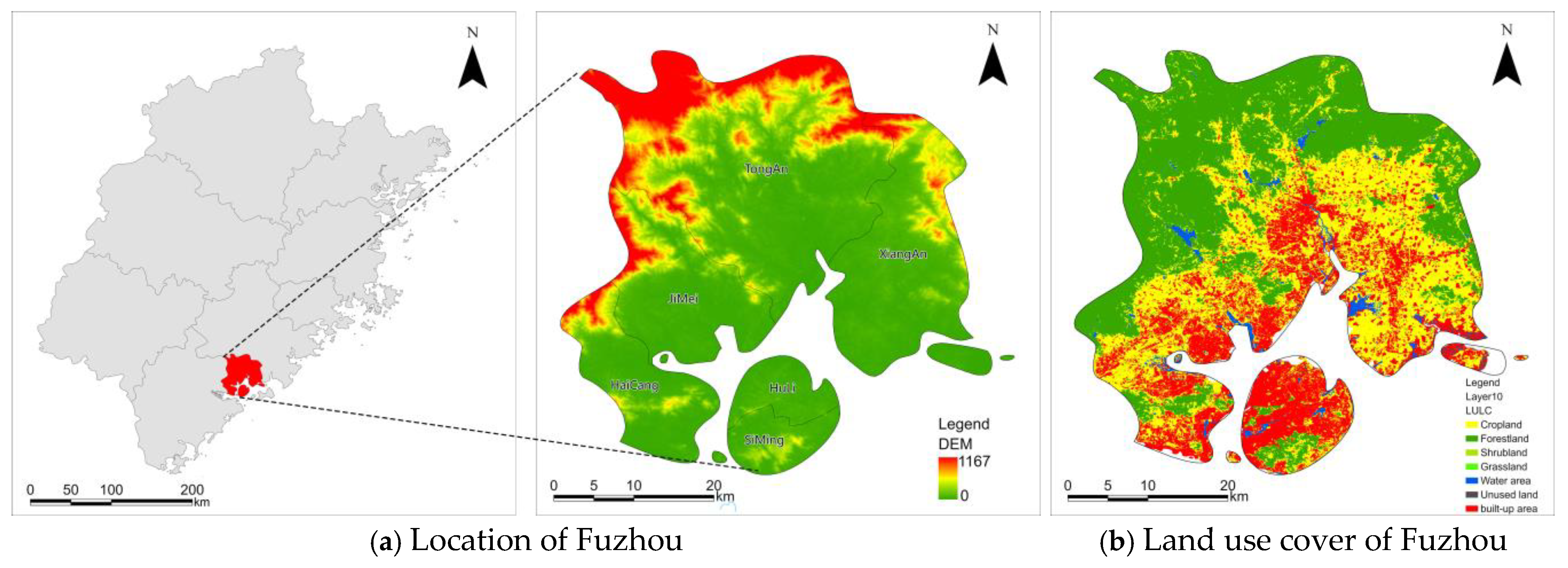
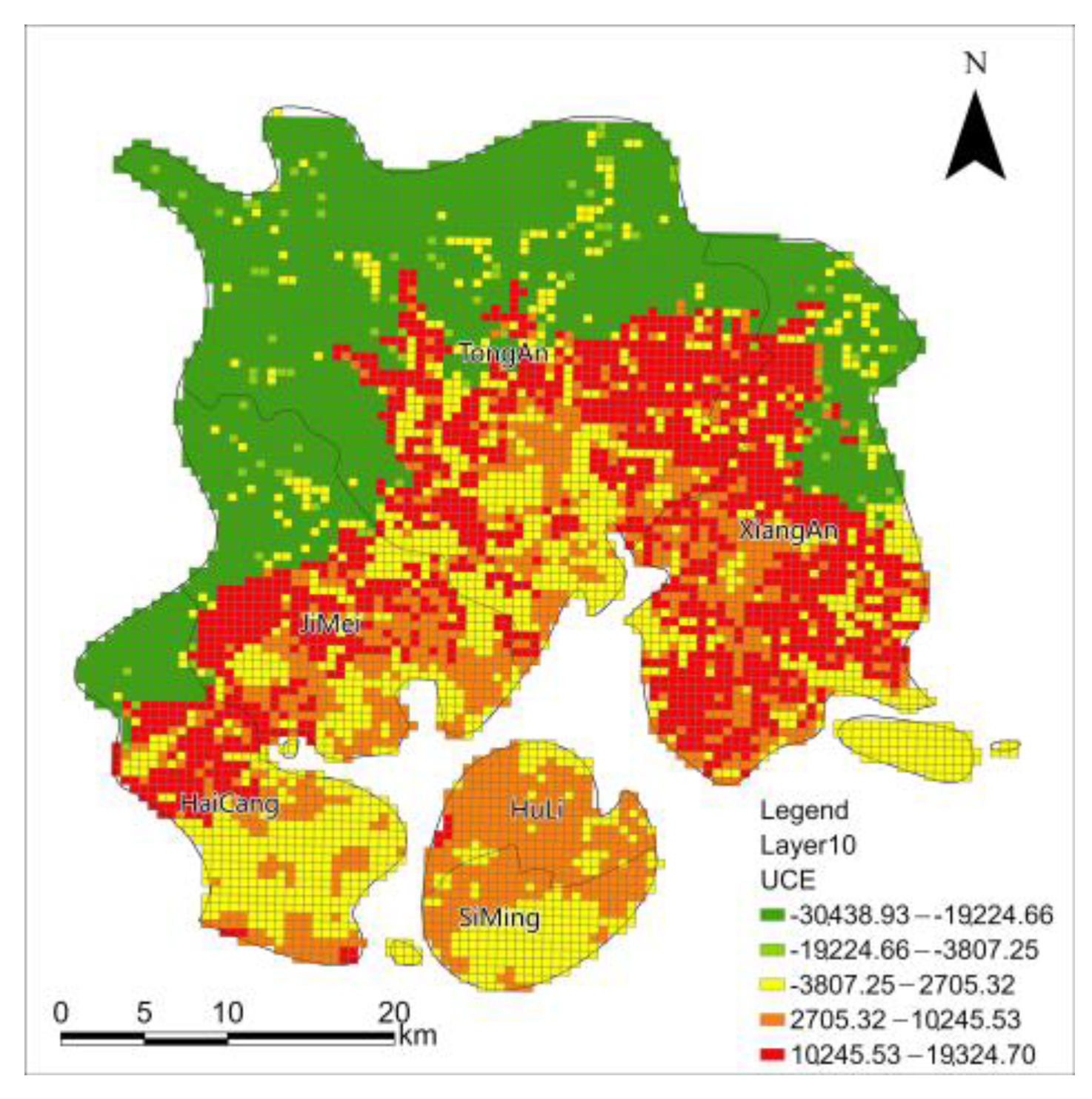

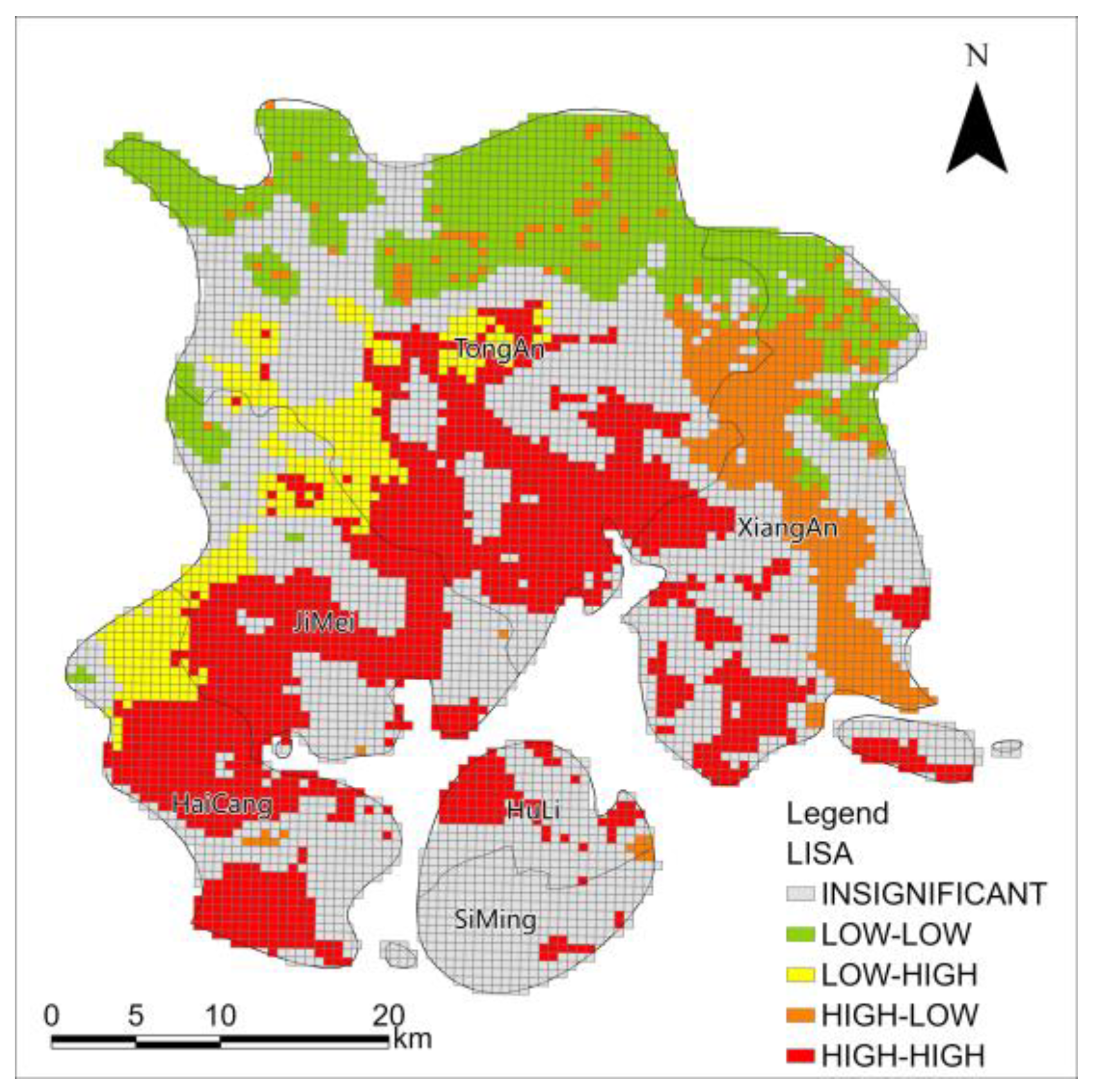
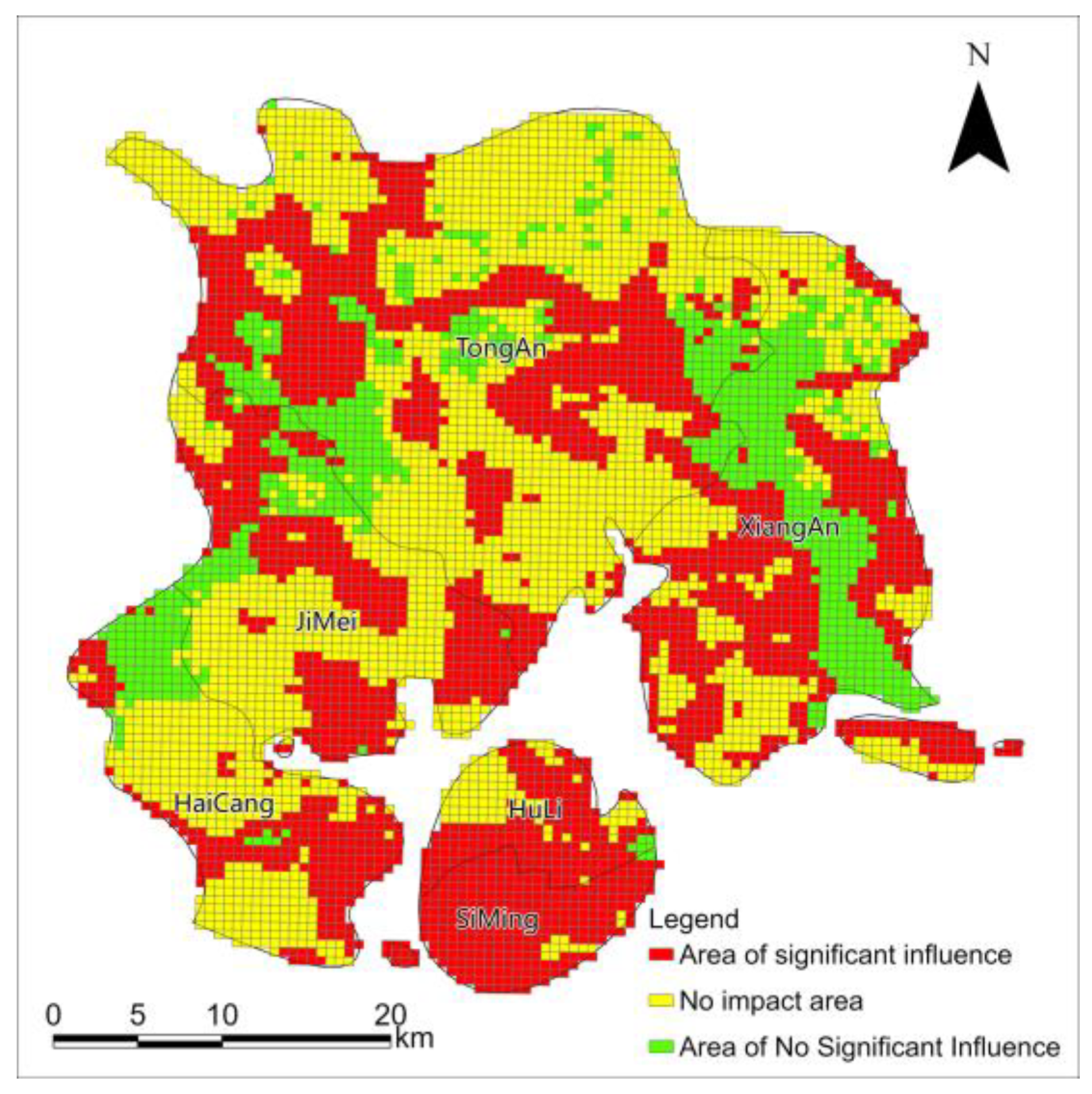
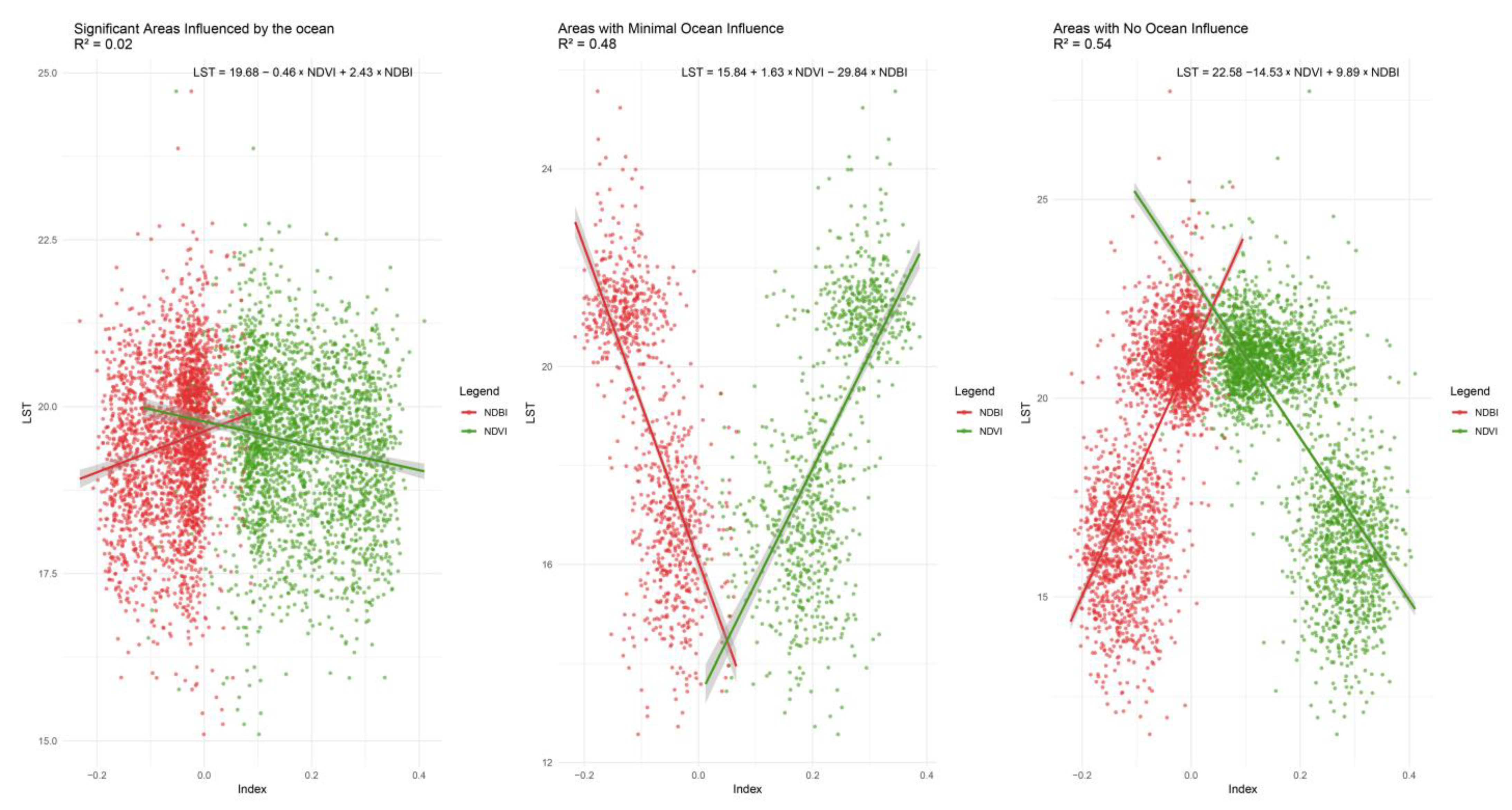
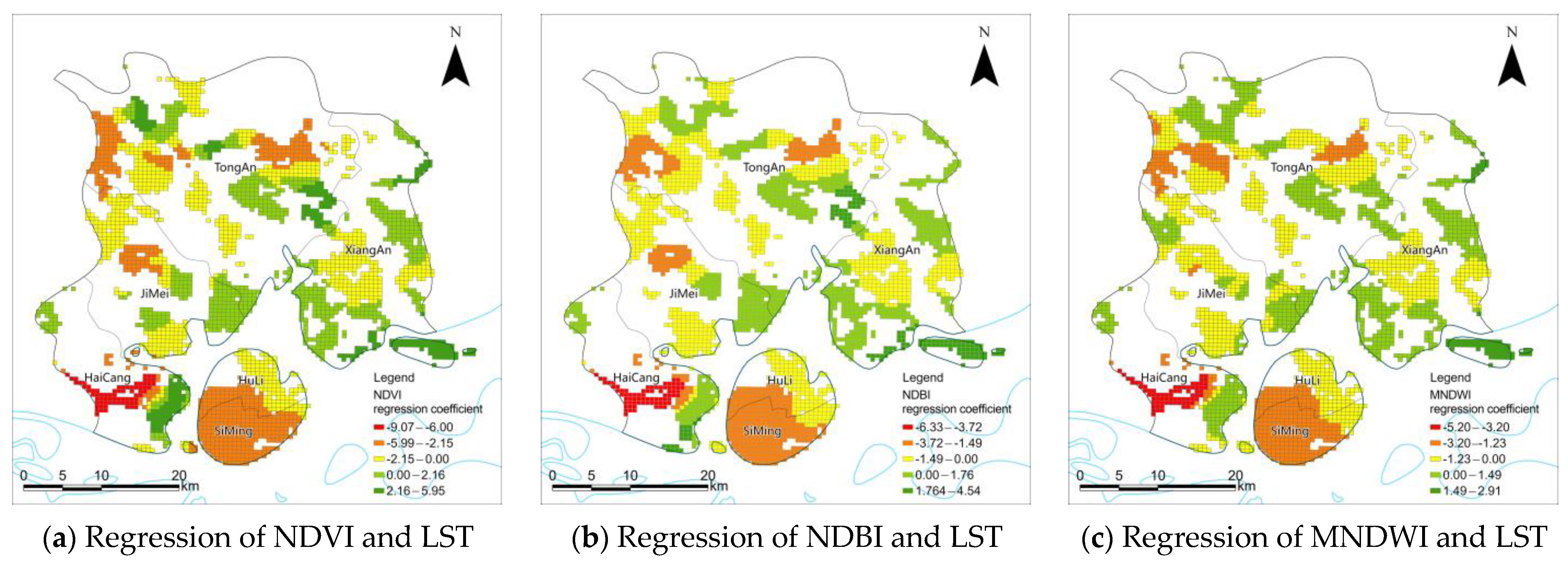
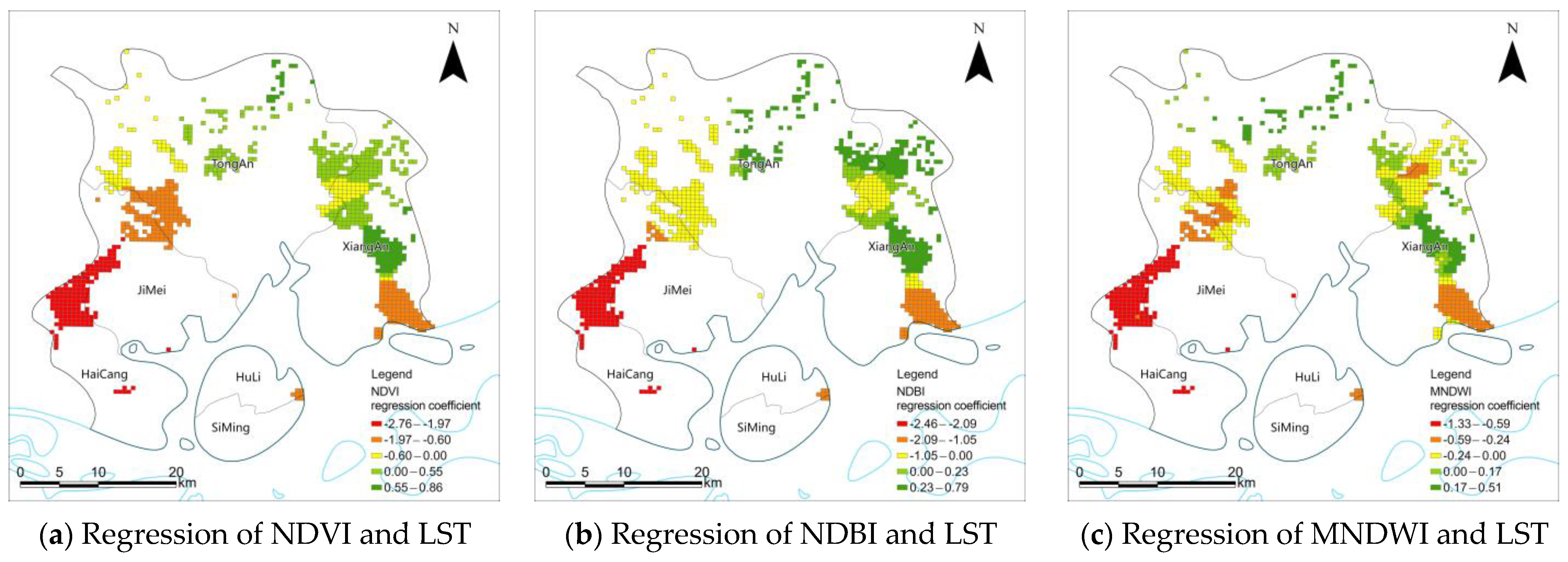
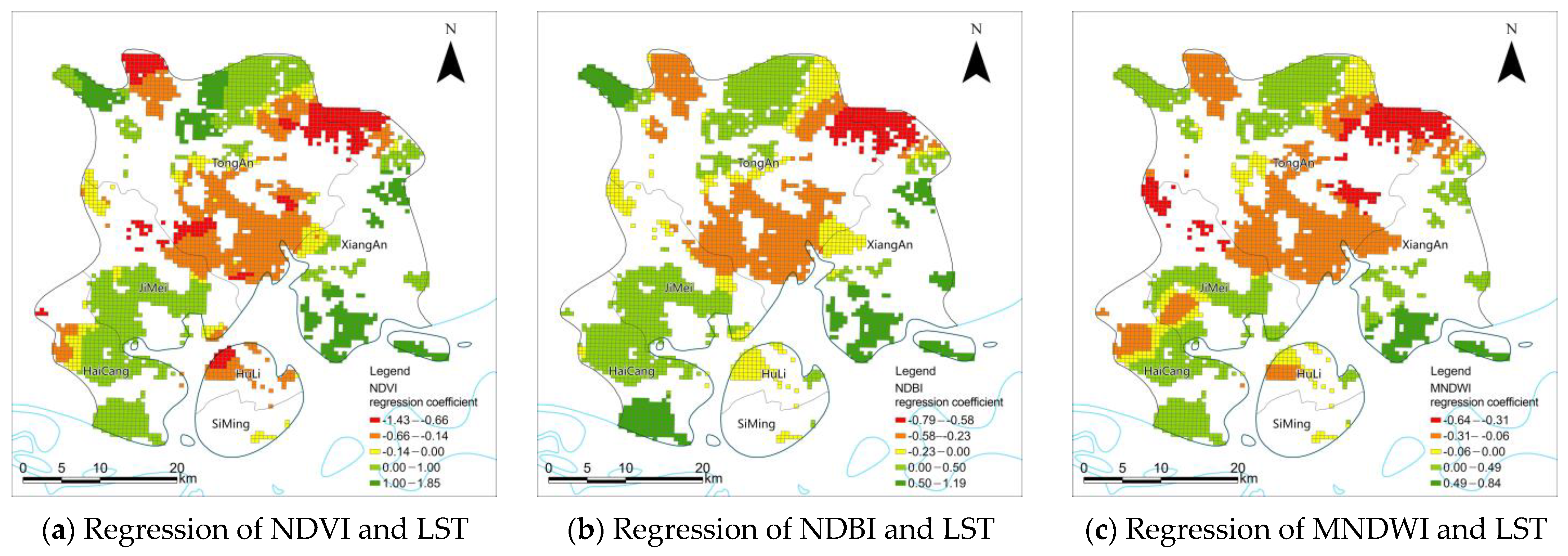
| Data Name | Data Source |
|---|---|
| Boundary of the study area | Fujian Province Standard Map Service System, Approval Number: Min S(2023)254 |
| Landsat remote sensing images within the study area | Geospatial Data Cloud, https://earthexplorer.usgs.gov/ (accessed on 10 September 2024) |
| Land use data within the study area | https://zenodo.org/record/5816591#.Y6ALbu2-uLU (10 September 2024) |
| Temperature within the study area | Inverted from Landsat8 images |
| Monthly and yearly NPP-VIIRS remote sensing data | https://eogdata.mines.edu/products/vnl/ (10 September 2024) |
| Energy consumption data in Fujian Province | China Energy Statistical Yearbook |
| Land Use | Carbon Emission Coefficient | Unit |
|---|---|---|
| Cropland | 0.0422 | kg/(m2·a) |
| Forestland | −0.0578 | kg/(m2·a) |
| Shrubland | −0.0578 | kg/(m2·a) |
| Grassland | −0.0021 | kg/(m2·a) |
| Water area | −0.0252 | kg/(m2·a) |
| Wetland | −0.0252 | kg/(m2·a) |
| Unused land | −0.0005 | kg/(m2·a) |
| Year | Coal (104 t) | Coke (104 t) | Crude Oil (104 t) | Gasoline (104 t) | Kerosene (104 t) | Diesel (104 t) | Fuel Oil (104 t) | Natural Gas (106 m3) | Electricity (106 kWh) |
|---|---|---|---|---|---|---|---|---|---|
| θi | 0.7143 | 0.9714 | 1.4286 | 1.4714 | 1.4714 | 1.4571 | 1.4286 | 1.2143 | 0.4040 |
| λi | 0.7559 | 0.8550 | 0.5857 | 0.5538 | 0.5714 | 0.5921 | 0.6185 | 0.4483 | 0.7935 |
| 2021 | 10,104.87 | 858.85 | 2839.74 | 540.19 | 117.24 | 429.63 | 189.03 | 60.04 | 2856.27 |
| GWR Model | MGWR Model | ||
|---|---|---|---|
| Influenced area | R2 | 0.33 | 0.47 |
| Adjusted R2 | 0.23 | 0.36 | |
| AICc | 7012.75 | 6921.73 | |
| Area not significantly influenced | R2 | 0.87 | 0.88 |
| Adjusted R2 | 0.83 | 0.86 | |
| AICc | 1144.39 | 1009.47 | |
| Area not influenced | R2 | 0.91 | 0.91 |
| Adjusted R2 | 0.88 | 0.89 | |
| AICc | 2397.49 | 2263.29 |
| NDVI | NDBI | MNDWI | |||
|---|---|---|---|---|---|
| Areas significantly influenced by the ocean | LST | Pearson Correlation | −0.147 ** | 0.156 ** | 0.043 * |
| p-value | 0.000 | 0.000 | 0.028 | ||
| Cases | 2649 | 2649 | 2649 | ||
| Areas less significantly influenced by the ocean | LST | Pearson Correlation | 0.659 ** | −0.696 ** | 0.074 * |
| p-value | 0.000 | 0.000 | 0.025 | ||
| Cases | 921 | 921 | 921 | ||
| Areas non-significantly influenced by the ocean | LST | Pearson Correlation | −0.730 ** | 0.706 ** | 0.401 ** |
| p-value | 0.000 | 0.000 | 0.000 | ||
| Cases | 2743 | 2743 | 2743 | ||
Disclaimer/Publisher’s Note: The statements, opinions and data contained in all publications are solely those of the individual author(s) and contributor(s) and not of MDPI and/or the editor(s). MDPI and/or the editor(s) disclaim responsibility for any injury to people or property resulting from any ideas, methods, instructions or products referred to in the content. |
© 2025 by the authors. Licensee MDPI, Basel, Switzerland. This article is an open access article distributed under the terms and conditions of the Creative Commons Attribution (CC BY) license (https://creativecommons.org/licenses/by/4.0/).
Share and Cite
Hong, T.; Huang, X.; Lv, Q.; Zhao, S.; Wang, Z.; Yang, Y. Thermal Mitigation in Coastal Cities: Marine and Urban Morphology Effects on Land Surface Temperature in Xiamen. Buildings 2025, 15, 1170. https://doi.org/10.3390/buildings15071170
Hong T, Huang X, Lv Q, Zhao S, Wang Z, Yang Y. Thermal Mitigation in Coastal Cities: Marine and Urban Morphology Effects on Land Surface Temperature in Xiamen. Buildings. 2025; 15(7):1170. https://doi.org/10.3390/buildings15071170
Chicago/Turabian StyleHong, Tingting, Xiaohui Huang, Qinfei Lv, Suting Zhao, Zeyang Wang, and Yuanchuan Yang. 2025. "Thermal Mitigation in Coastal Cities: Marine and Urban Morphology Effects on Land Surface Temperature in Xiamen" Buildings 15, no. 7: 1170. https://doi.org/10.3390/buildings15071170
APA StyleHong, T., Huang, X., Lv, Q., Zhao, S., Wang, Z., & Yang, Y. (2025). Thermal Mitigation in Coastal Cities: Marine and Urban Morphology Effects on Land Surface Temperature in Xiamen. Buildings, 15(7), 1170. https://doi.org/10.3390/buildings15071170






